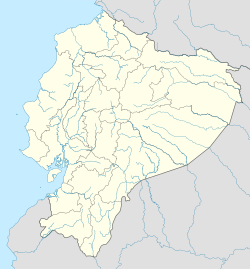Gonzanamá
| Gonzanamá | |
|---|---|
| Coordinates: 4°13′53″S 79°26′7″W / 4.23139°S 79.43528°WCoordinates: 4°13′53″S 79°26′7″W / 4.23139°S 79.43528°W | |
| Country | Ecuador |
| Province | Loja Province |
| Canton | Gonzanamá Canton |
| Government | |
| • Mayor | Miguel Angel Briceño |
| Population (2001) | |
| • Total | 1,539 |
| Time zone | ECT |
| Climate | Cwb |
Gonzanamá is a small town and also part of one of the 16 cantons (Gonzanamá) in Loja Province, Ecuador.
The name of the city was created by two different native languages of Ecuador: Spanish and Quechua. The name of the cacique from the tribe of the anamaés is Gonza and the name of the coveted territory, which means favorite to the god of the water, is Anama or Munamá. Another meaning of the name is break of hills, because the city is located on the „Andes’s Mountains“.
After the Spanish conquest came some Dominicans, who have founded "The doctrine of Santo Domingo de Gonzanamá".
This was formed from different big confederations:
During the colonization, the citizens of Gonzanamá reacted. They did not want to be submitted by the Spanish people. This was when the town decided to write the Declaration of Independence on 17 February 1822. At the beginning Gonzanamá was just a rural parish from the canton of Loja. On 27 September 1943 the Government of Dr. Carlos Arroyo del Rio created legislative Decree number 928 for it to become a big canton. This was officially published on the 30 September 1943.
Distance from Gonzanamá to Loja (capital city of Loja Province): 81 km
The first authority is a called mayor, who is selected every 5 years. It has a municipality. The last mayor was Norman Espinoza and the current mayor is Paulo Guerrera.
It is divided into:
The population represent 3.7% from all the population of Loja and it grows every year about 1.3%. 89.7% of the population are residents of the rural area and it is characterized of young people, because 45.8% of them are under 20.
The 14.987 inhabitants are divided as:
Most of the people dedicated their lives to the agriculture of tomatoes, sugar cane and other products. Cattle raising is another way to survive for the inhabitants of Gonzanamá, especially in the area of Colca. Timber production is very high and one of the most popular trees is the pine. Hand craftsmanship is also practiced. The native language is Spanish.
Gonzanamá has a subtropical highland climate (Köppen: Cwb). The light showers and small storms are very common.
Gonzanamá was devastated by an earthquake on the last century, which also toppled the principal church of the town.
Temperature: 18 °C (11 °C – 22 °C)
There are also many parties, which are celebrated every year.
The date of the party will be planned every year. Special guests will be invited and parades-competitions of horses. At the party dimantina (a mix of fresh milk and alcohol) will be offered for all the people. The exhibition of beautiful crafts is also a part of this party.
...
Wikipedia

